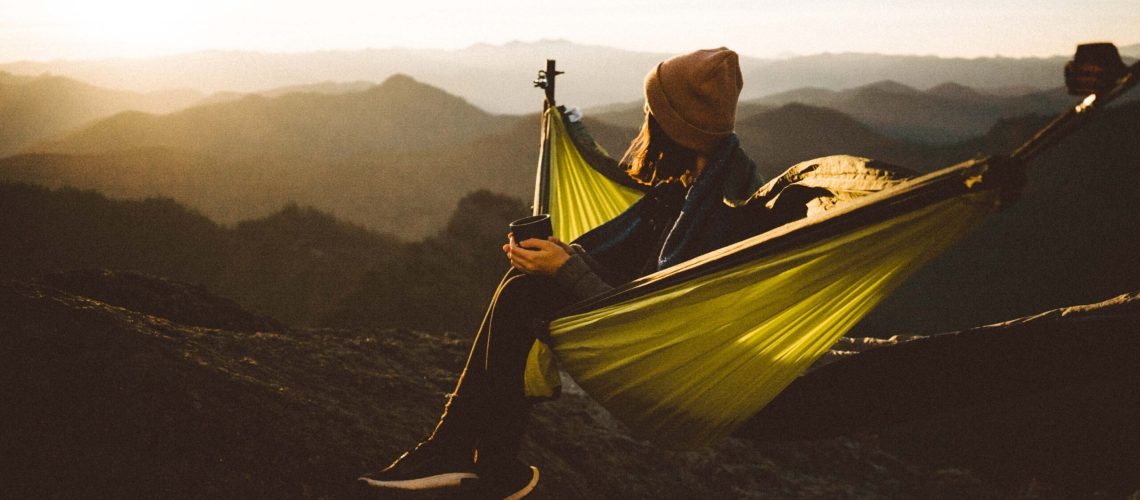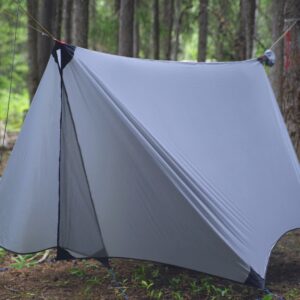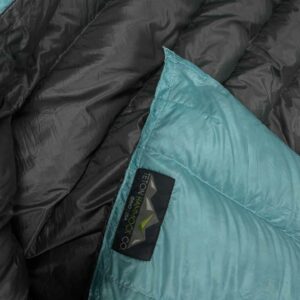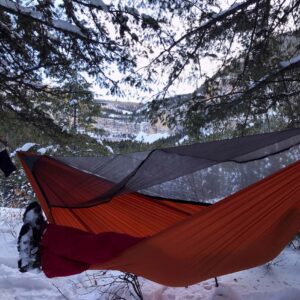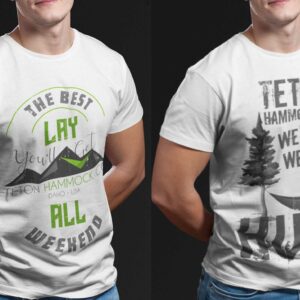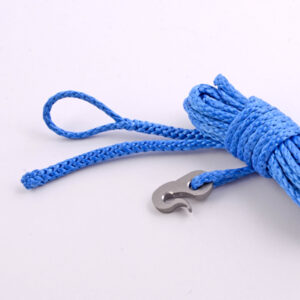After walking all day with your pack, you want to lay down and go “..ahh..” It’s that feeling that hammock lovers know too well, right before slipping into a deep, peaceful sleep. In the morning, you wake up fresh and rejuvenated. Another good day to hike! All you need is a light load and a goodnight’s sleep.
But even with the best backpacking hammock, a few common mistakes may rob your sleep. To help you avoid such mistakes we have created this guide that will show you how to sleep comfortably in your hammock and travel light.
Use The Best Backpacking Hammock Gear
The best hammock system for backpacking depends on your needs. As you plan your trip, consider the following.
The Campsite And Weather
If you intend to camp during warm nights only, your load will be lighter. You will only need your suspension system, hammock, sleeping bag, and sleeping pad. But if you camp with your hammock in winters, then you need more to stay warm. You’ll need a backpacking hammock tarp, an under quilt, and maybe a top quilt.
More needs mean more luggage.
Knowing this, we design our hammock camping gear with ultralight yet durable materials. Would you take a look at the weight in our product descriptions? You will be surprised that our resilient hammocks and tarps are incredibly light!
Choose The Best Size For Your Hammock.
The more room you have to wiggle in your gathered-end hammock, the better.
Do your research and plan for what you need. Better still, experiment with whatever you have at home and try out the sleeping positions. You can’t go wrong with practice! Find out exactly what you need for your backpacking trip in our hammock camping essentials.
Set Up Your Backpacking Hammock The Right Way
Use these tips to set up your backpacking hammock.
Hang Your Hammock With A Gentle Sag.
Avoid sagging so deep that the hammock forms a V shape. That will hurt your back. And also, don’t tighten it too hard. That builds tension on your hammock system, which could easily break it.
You want a gentle sag, like a standard smiley face. It keeps your back almost straight, as long as you lay in the proper position (discussed below). You can estimate the sag with your index finger and thumb.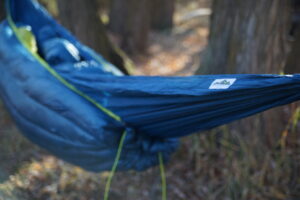
Shape an L with your thumb and index finger. Then with your index finger parallel to the ground, touch your strap’s edge with the tip of your thumb and index finger. If both fingertips touch the strap to form a right-angled triangle, that’s roughly 30 degrees elevation. It’s the perfect sag.
But the sure way to know your perfect sag is to lay on it. So set it up and test it. Do you feel comfortable?
Raise The Foot End Higher Than The Head End.
As you lay on a hammock longer, you will slowly slide towards the center. That’s the effect of gravity on your heavier torso. Counter this effect by raising the foot end about 8 to 12 inches higher than the head end. Simple, and you won’t have to keep shifting back to the correct position throughout the night.
Hang Your Hammock While Standing.
That means you will hang the ends of your hammock about 5ft off the ground. And when you lay on it, you’ll hang about 18inches above the ground. That’s a standard sitting height and very stable for a hammock.
It’s easy to climb in and out of your hammock. Plus, you can sleep better knowing that even if you fell, it won’t be fatal.
Use Hammock Straps To Fasten Your Hammock.
Straps are stretch-resistant (unlike ropes). Straps keep your hammock in the position you hang it in till morning. Additionally, ropes tend to dig into a tree after constant use. Help preserve trees’ barks by using hammock straps instead of ropes.
Lay Properly In Your Hammock
When set up right, hammocks take good care of your back. Well, unless you sleep in the wrong position. The wrong position is lying like a banana in your hammock. Instead, it would be best if you slept diagonally.
Picture a straight line running across your hammock from head to foot. With your backpacking hammock set up, this would be the ridgeline. Instead of lying parallel to the line, do this. Lay with your feet pointing to the right and your head pointing to the left.
It’s called the asymmetrical’ or diagonal lay. When you sleep this way, your back remains relatively flat. If you feel any straining on your knees, find a better position. Or add a knee pillow under your knees. Again, experiment with your hammock till you find your ‘sweet spot.’
Use Bug Nets
It’s so good to read a book while leaning back on a hammock. You don’t want disruptions from random bugs. Some of our off-the-shelf hammocks come with integrated bug nets. For the rest, you will need to buy a separate bug net. Or make one at home. When you order a custom backpacking hammock, you choose whether to get an integrated bug net. Whatever you do, don’t underestimate the bug net. It’s crucial for a good evening nap.
Use A Backpacking Hammock Tarp
If you are camping in the wet seasons, hammock tarps are essential. Tarps protect your setup from any wetness (rain and snow)—no need to worry about horizontal or diagonal rains with Teton Hammocks. Like other accessories, it’s vital to use your tarp the right way. Pitch your backpacking hammock tarp close to your hammock for maximum coverage. The tarp will also trap air over your body, keeping you warmer in the night.
Use A Dripline.
Besides a tarp, you need to catch rainwater coming to the hammock using the suspension. You break this water flow using a dripline. The dripline could be a shoelace, a stick, or some improvised lace. Tie the dripline on your straps. When rainwater reaches the dripline, it will flow to the ground instead of your bedding.
Insulate Your Back
You can sleep with frozen feet, but a frozen back?
A sleeping bag alone is not enough for the best backpacking hammock trip. You will have the wind blowing under you (and all around you if you don’t pitch a tarp). You can use sleeping pads to insulate your back. But in very low temperatures, you will also need an under quilt.
Sleeping pads
When using a single-layered hammock, you can place your sleeping pad inside the hammock. The apparent problem is that the pad will shift with you throughout the night. Expect to fix it a couple of times.
A sleeping pad works best with a double-layered hammock. You slip the pad into the space between the layers, and it stays in place all night. You can also add reflective material under you to reduce heat loss. As they insulate your back, sleeping pads help you sleep comfortably.
Under quilts
The most ideal option for hammock camping on cold nights is an under quilt. Under quilts are thick insulating fabrics that you place under your hammock. They break the wind and insulate your back. The air trapped between your hammock and the under quilt reduces heat loss.
Fold Your Hammock Into A Chair While Sitting
The best thing about hammocks is that they work as both a bed and chair. It’s so much easier to wear your boots. And when you are so tired that you want to sit, the hammock does the deal.
You don’t need to change anything to sit on your hammock. But you can modify the hammock to be a better chair.
Pick one edge of the hammock, roll it over to meet the next edge. That’s it! It becomes a shorter, more stable chair.
In addition to this, if you are wondering as to where to put your stuff at night, then some hammocks have storage sleeves sewn within them. You can store and easily reach your headlight at night.
If you need more space, you have options. Here are some:
- Hang your pack (and boots) on a tree, and cover with some plastic cover.
- Hang your pack (and boots) on your ridgeline or straps. Your backpacking hammock tarp should shelter them. If not, cover them with a plastic bag.
- Leave your boots and bag on the ground. But protect them from water with a plastic cover. Stuff your socks into your shoes to prevent any crawlers from getting in there. Remember to shake the boots in the morning before you wear them.
- Buy a gear hammock. This is a small hammock you hang next to your hammock for storage.
- Alternatively, you could sew up your storage sleeves with a simple cloth or net.
Ultimately, the method you choose to store your stuff depends on your taste and needs. For example, if you need your boots at night, it’s better to keep them closer to you than hang them on a nearby tree. Pack away your stuff with such considerations in mind.
There are many options to consider when designing your backpacking hammock system. Therefore, start by determining your needs first. Then, select your hammock and accessories to suit your requirements. When you shop at Teton Hammock Company, you customize your hammock down to the colors and the seams.
Get The Best Backpacking Tarp And Hammock From Teton Hammock Company
We specialize in creating top-quality hammocks, tarps, and accessories for extreme conditions. These are the hammock gear we use and believe in. If you’re not sure about how to choose your backpacking hammock system, we’re here to address any of your questions and concerns.

